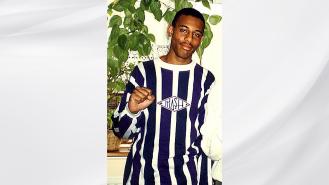
Dragged for 3 miles behind a pickup: The racist Murder of James Byrd Jr
On June 7th 1998, a member of the public came across the partial remains of an African American man outside of a predominantly Black church on Huff Creek Road, Jasper, Texas. When the police arrived, they followed a bloody trail up a dirt road and found the victims head, neck and arm. They were able to identify the victim by his wallet that was found near the crime scene.
Forty-nine-year-old James Byrd Jr was a local man known for his friendly personality and love of music and singing. He was born in Beaumont, Texas in May 1949 and attended J.H Rowe High School in Jasper, where he was raised. He graduated as part of the last segregated class in 1967. James had last been seen by friends and family at a party the previous evening when he left to walk home as he suffered from seizures and couldn’t drive as a result.
Along the trail where James' remains were found, the investigators uncovered one of the most horrific scenes imaginable. There were areas of flattened grass and blood, and tissue found in numerous places. James had his face spray painted black, he had been beaten, urinated on, and then dragged for over 2 miles behind a vehicle. The killers left identifiable items at the scene; a lighter that had the name ‘Possum’ and ‘KKK’ engraved on it, a wrench engraved with the name Berry, three cigarette butts, a can of black spray paint, a pack of cigarettes, beer bottles, James’ baseball cap, and a button from his shirt.
The following day a man named Shawn Berry was pulled over for an unrelated matter, and officers spotted tools in his pickup truck that matched the wrench they found. When they carried out a forensic examination on the truck, they found James Byrd Jr’s blood in several locations. The tyres on the truck matched imprints found at the scene. Shawn Berry lived with two men, John King, who he knew since high school, and Lawrence Brewer. John King and Lawrence Brewer met while they were in prison, they were both white supremacists. Possum was John King's prison nickname.
An autopsy carried out on James Byrd Jr concluded that his cause of death was the separation of his head, neck, shoulder and arm from his body. As he was dragged behind Berry’s pickup truck, he had tried to protect his head by keeping it up, but his body hit a culvert in the road which caused him to be decapitated. He died instantly at that point but he had endured incredible pain before then. His skin had been worn down to muscle and bone, and he suffered many broken bones.
The men had come across James as he was walking home, they offered him a lift and he gratefully accepted. Instead, they took him to an isolated area where they tortured, humiliated and killed him. All three men were convicted of capital murder, Brewer and King were known members of white supremacist groups and so the murder was classified as a hate crime. Their DNA was found on the three cigarette butts, James’ blood was found on their clothing, the evidence was overwhelming. The three men were tried separately. Berry was sentenced to life in prison, he will be eligible for parole in 2038. Brewer and King were sentenced to death. Before Brewer was executed in 2011, he told KHOU news in Houston that he had no regrets and that he would do it all over again.
The practice of allowing death row inmates in Texas to choose their final meal was stopped because of Brewer. After ordering an enormous amount of food including; pizza, burgers, chicken steaks, an omelette, a pound of BBQ meat, fajitas, a tub of ice cream, a tray of peanut butter fudge and three root beers he said he wasn’t hungry.
John King attempted to appeal his death sentence and applied for a stay of execution. He was ultimately executed in April 2019. James Byrd Jr’s family campaigned to spare the murderers’ lives, working alongside charities that strive for reconciliation and oppose the death sentence.
While King was awaiting trial he wrote a letter to Brewer that was signed off with 'Seriously though Bro, regardless of the outcome of this, we have made history and shall die proudly remembered if need be... Much Aryan love, respect, and honor (sic), my brother in arms... Possum'.
However, the outcome of James Byrd Jr’s death did make history but not for the intended reasons. The civil rights Act of 1968 made it a federal crime to hurt or interfere with a person because of their nationality, religion or race but its scope was not wide enough. In 2009, President Barack Obama signed into law the Matthew Shepard and James Byrd Jr Hate Crimes Prevention Act. This expanded on the hate crime legislation that was already in place to include crimes against someone because of their gender, sexuality, gender identity, sexual orientation or disability. The Act defines a hate crime as when a defendant chooses a victim because of their race, religion, nationality, ethnicity, gender, sexuality or disability, removing some of the legal barriers that hindered hate crime prosecutions before.
It was named after James Byrd Jr. and another victim of a hate crime, Matthew Shepard. Matthew was a 22-year-old university student, who was tortured and killed because he was gay. Both crimes occurred in 1998, and although they finally focussed the public eye on hate crimes, it took 8 years for the Act to be passed and implemented.
The act is not the only positive legacy from the senseless killing. The Byrd family created the Byrd Foundation for Racial Healing in 1999, as a testament to James. While James Byrd Jr’s three children have continued to campaign for change and reconciliation since their father's death







